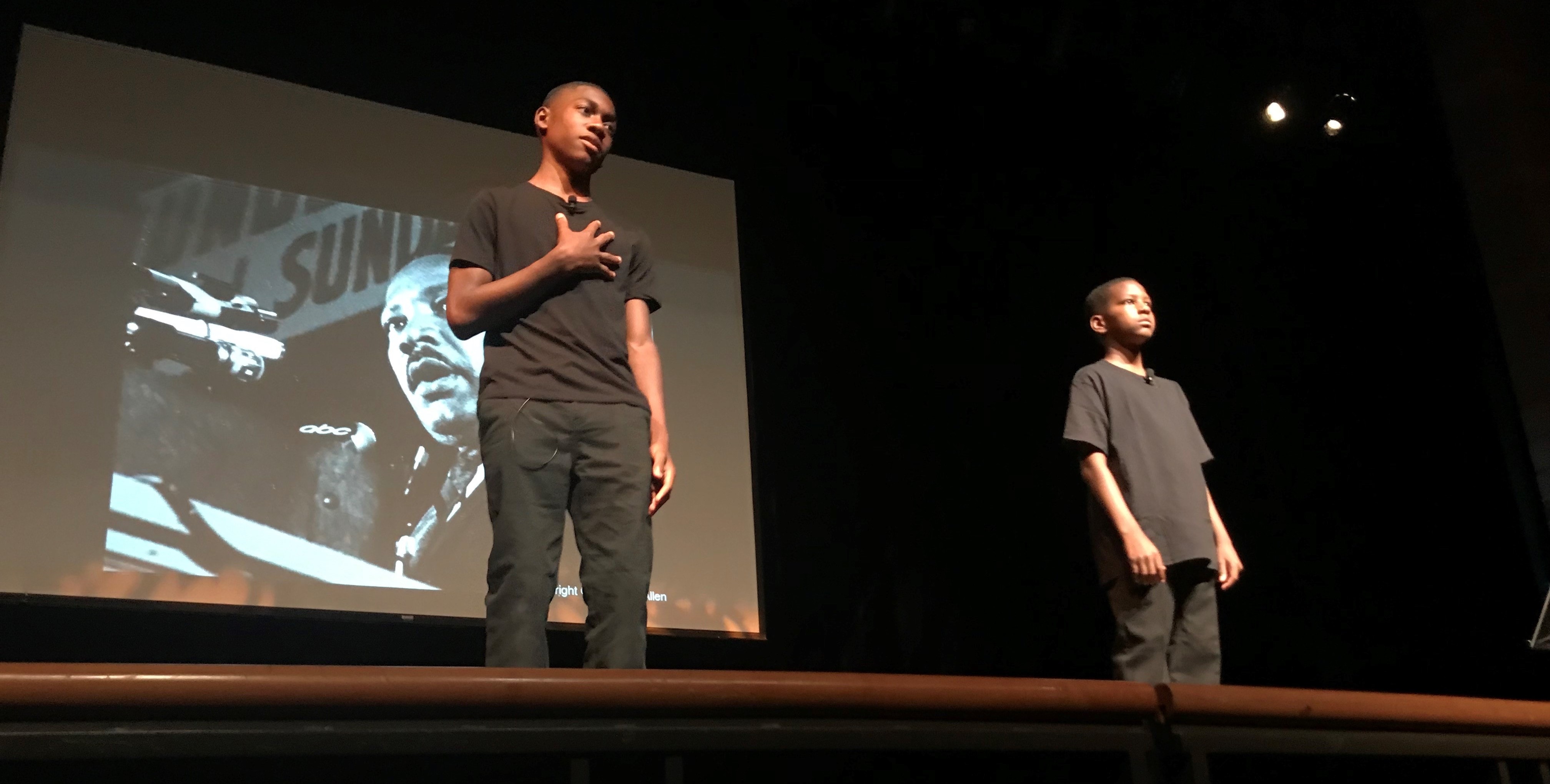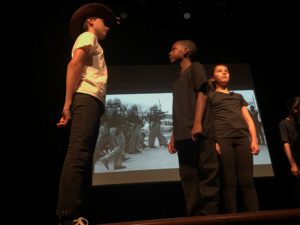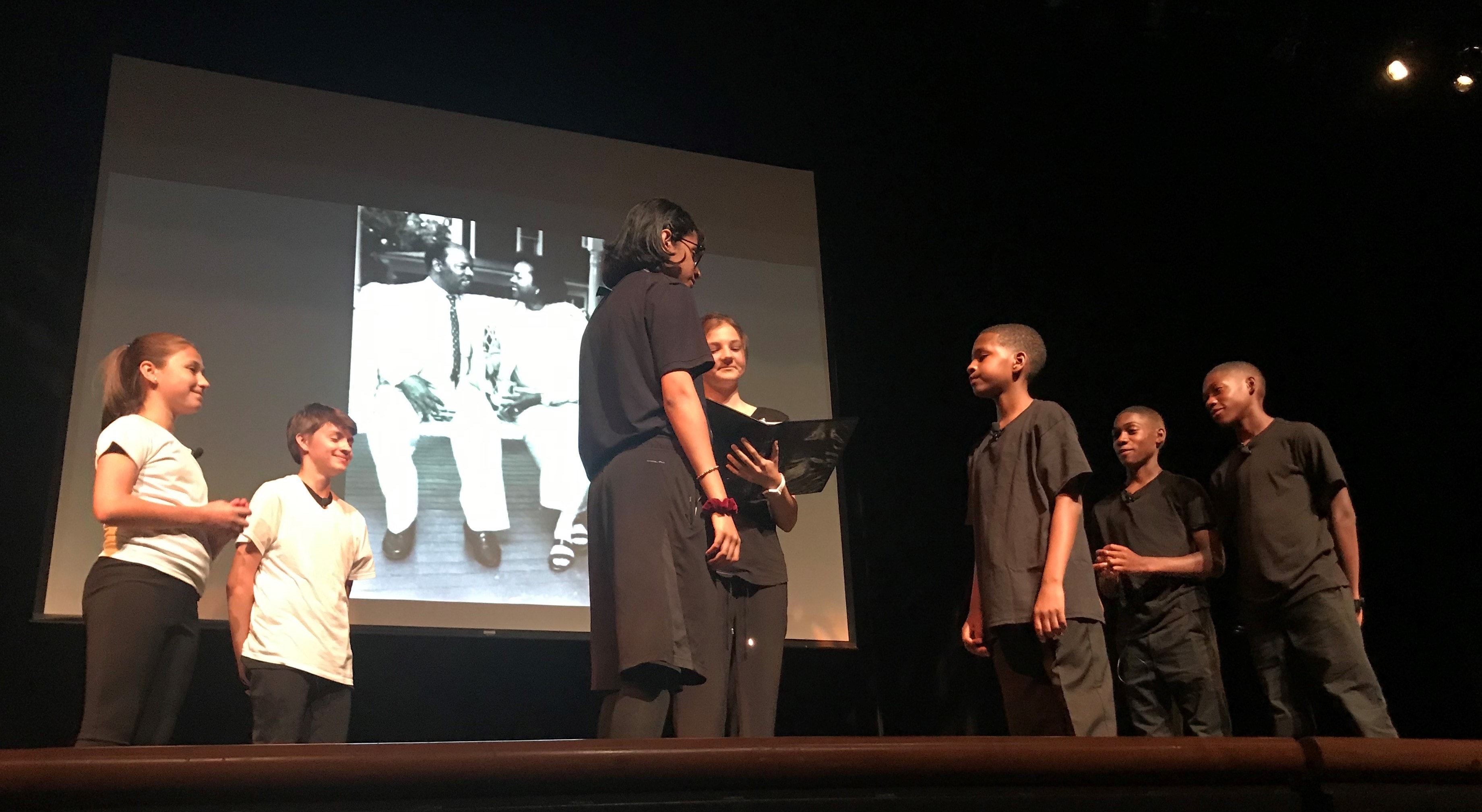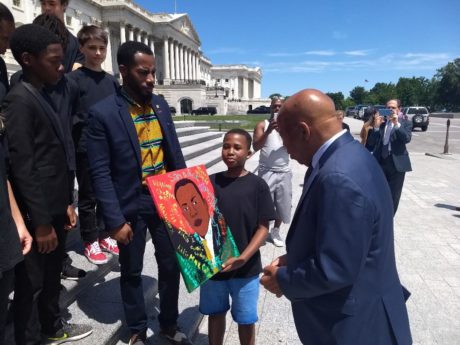One looks for hope where one can find it. And sometimes hope pops up on its own, unexpected. That kind of hope, not sought out, can catch in one’s throat, can even move one to tears. Such was what happened when I watched a one-night-only original musical production based on the life of the legendary Civil Rights Movement leader John Robert Lewis, performed by a racially diverse group of ten boys and girls who attend the Rose L. Hardy Middle School.

This was obviously no professional theater production, and this was not the kind of play one often sees with an uplift message tacked on at the end so audiences do not leave bummed. This was instead a performance suffused with implicit hope from the moment its young cast took the stage.
They had me at “Hallelujah,” their first musical number together. And it wasn’t so much the quality of their vocals that moved me; it was the generational promise in their racial harmony and the transparency of their sincerity that shone through.

The show had been introduced and framed by grownups: Leon Clark singing “Go Down Moses” in his rich, warm baritone a cappella and George Shirley reading the ringing words of Dr. Martin Luther King Jr.’s Letter from a Birmingham Jail from a lectern stage right. Overhead began a succession of eloquent documentary photographs of Dr. King, Congressman Lewis, and the Civil Rights struggle.
In this august context on the huge THEARC Theatre stage, the kids might have seemed diminutive, diminished, but even in their youthful awkwardness and fledgling poise, their singing and simple storytelling owned every moment.

The show touched on six episodes in John Lewis’s life beginning with his boyhood in Troy, Alabama, where he was denied a library card in a “whites only” library—a scene acted out with choreographed playground games. The cast mimed pickaxes as the scene shifted to the harsh labor tenant farmers endured. We learned young Lewis practiced preaching to chickens. And early on, we were told, he embraced the ideals of patience, compassion, and nonviolence.
The story continued with the event in 1957 when Lewis was 17 and Dr. King sent him a bus ticket to come to Atlanta to meet with him, later tagging him “the boy from Troy.” Watching two slight ensemble members act out the momentous event between these monumental historical figures was touching beyond words.


Particularly poignant was a scene depicting the confrontation between voting-rights marchers and state troopers in Montgomery, Alabama, on “Bloody Sunday” in 1965. For different episodes in the show, the students would slip offstage to change T-shirts such that white or black represented the race of the characters they were playing. The T-shirt color was not necessarily the race of the student, which became the subtextual point. The weight of that costuming choice on the parts the students played was powerful, notably in a beautiful musical mashup when half the cast wearing white sang “America the Beautiful” while half the cast wearing black sang “We Shall Overcome.”
Robert F. Kennedy entered the story, and when a student portraying him delivered his announcement that Dr. King has been shot, it sent chills. Also expressive were scenes shown in projections and depicted onstage of Lewis’s marriage to Lillian Miles, his election to Congress in 1986, and President Obama’s bestowing on him the Medal of Freedom.

As the large-screen filled with images documenting John Lewis’s life and the Civil Rights Movement, the stirring sight of these 6th, 7th, 8th, and 9th graders earnestly telling the stories seemed a glimpse at what Dr. King might have meant when he dreamt of children one day living in a nation “where they will not be judged by the color of their skin but by the content of their character.”
The ensemble’s final song together was “Imagine.” I doubt there was a dry eye.
Running Time: About one hour, with no intermission.
The Boy from Troy played June 26, 2019, at THEARC Theater – 1901 Mississippi Ave SE, Washington, DC, as part of the 2019 DC Black Theatre & Arts Festival.

The Boy from Troy had its world premiere at the Rose L. Hardy Middle School in June 2018 and was invited by the DC Black Theater & Arts Festival to be performed at the THEARC—the first time a DC Public Schools production has been so recognized.
The production grew out of Paul Reif’s History Day project in 2017. The theme that year was “Taking a Stand,” and Paul selected Congressman Lewis and was able to interview him for his multimedia report.
In 2018 the students met with Congressman Lewis on the steps of the Capitol and sang for him one of the show’s numbers, “Hallelujah.”
The Boy from Troy program credits:
Artistic Director: Romas Maith; Musical Director: Leon Clark; Producer: Tim Reif
Scenes I, II, IV Adapted by Romas Maith; Scenes III, VI Adapted by Tim Reif; Scene V Excerpts from President Johnson’s Voting Rights speech chosen by students
Digital Images: Paul Reif; Mural: Stephen Newbold and His Fine Arts Students; Piano: Mason Eva-Buckner
Act One, Early Years
Scene 1: Walking with the wind — A tornado threatens the house
Scene 2: Library Card — John Lewis is turned away
Scene 3: John Lewis meets Dr. Martin Luther King, Jr.
Act Two: Later Years
Scene 4: Bloody Sunday — Voting Rights March of March 7, 1965
Scene 5: Excerpts from President Johnson’s Voting Rights speech
Scene 6: John Lewis and the civil rights movement in transition
Based on Walking With the Wind, A Memoir of the Movement, by John Lewis with Michael D Orso, and March, A Graphic Novel, by John Lewis, Andrew Aydin and Nate Powell
Ensemble Cast
Sarah Albannai, 8th grade; Aaron Curtis, 6th grade; Mason Eva-Buckner, 8th grade; Noel Mulugeta, 8th grade; Paul Reif, 9th grade; Sarah Reif, 7th grade; Lily Roslof, 8th grade; Katrina Tracy, 8th grade; Elijah Wynn, 7th grade; Isaiah Wynn, 7th grade
With special appearances by Leon Clark, singing “Go Down Moses,” and George Shirley, reading excerpts from Letter from Birmingham Jail
MUSICAL SELECTIONS
“Go Down Moses”
“Hallelujah”
“America the Beautiful”
“We Shall Overcome”
“Ain’t Gonna Let Nobody Turn Me ’Round”
“Gone Too Soon”
“Imagine”
RELATED:
Opening Weekend at the DC Black Theatre & Arts Festival (Photo Feature) by Malcolm Lewis Barnes




